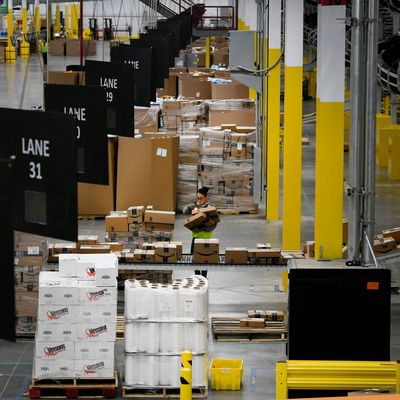
It’s not exactly a secret that many workers in Amazon warehouses are treated less than well. The Amazon system is aggressively streamlined, sending workers racing around warehouses, throwing items into boxes to get two-day shipped to Prime members, at a breakneck pace. Their efficiency is tracked, as are their bathroom breaks. A recent Supreme Court decision ruled that Amazon workers weren’t entitled to pay for the time they spent before and after their shifts getting screened by security. Sometimes they get bear-maced. Debilitating injuries can go unaddressed. Ambulances have waited outside some centers in case heat exhaustion sets in.
To combat this seemingly endless torrent of bad press, Amazon has been trying out a novel solution for the past year. “Novel,” in this case, means “very confusing and poorly executed.” It has asked some fulfillment center employees to moonlight as “Amazon FC Ambassadors,” which means that they go onto Twitter with handles like “AmazonFCSteve” and tell everyone that everything is good. They post pics from the break room and the warehouse floor. They talk about their personal lives. They want to let you know that Amazon is a good employer and treats everyone well and nobody is pissing their pants because they’re afraid of losing their job if they take a toilet break.
The reason this is all back in the news is because when a Twitter user responded to Amazon yesterday, she was swarmed with replies that made her feel like she was “talking to the borg” hive mind. The open-source investigation website Bellingcat found 53 Twitter accounts tied to the FC Ambassador program. All of them are tied to amazon.com email addresses and use a piece of enterprise-level, social-media software called Sprinklr to send their tweets. Curiously, Amazon will reuse accounts even as they cycle ambassadors in and out. Meaning you get tweets from a woman named Michelle on an account that currently belongs to Rafael.
The stilted tone of these accounts could aptly be described as “hostage’s proof-of-life video.” It doesn’t help that FC Ambassadors don’t actually own their accounts, and they rotate ownership on a daily basis. Maybe the people running them do really like Amazon (if you run an international network of thousands of employees, you’re gonna find a few happy ones), but “some of our workers (on a rotating basis) aren’t miserable all the time” is a pretty hollow message. And since many of the accounts have followers in the low double digits, it seems unclear whether these spokespeople have made any impression beyond becoming targets for mockery.
I understand the impulse for Amazon to defend itself and its practices. Companies do PR, and in this case, Amazon wants to get critics to tour their fulfillment centers. “Come see for yourself” is a decent PR tactic. What I’m not quite sure about is why in god’s name the company decided that Twitter was the best avenue for this, let alone employing the strange conceit of the “ambassador.” Twitter is not a place for persuasion, but for preaching to the choir. Nobody comes to Twitter to have their mind changed.
Many of the conversations that FC Ambassadors are engaged in feel more like interrogations from labor-rights proponents. I’m not sure who benefits in this situation. Low-level workers get clowned on online (they also reportedly get Amazon gift cards and time off from racing around the warehouse for their service), and Amazon’s reputation doesn’t improve. In many ways, it’s an example of the Streisand Effect — attracting attention to an issue that might have otherwise passed under the radar.





























